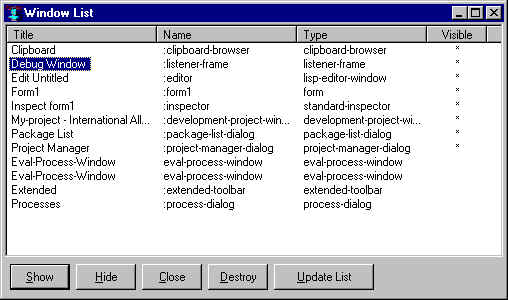

Displays a list of all top-level windows, displaying the title, programmatic name, type (i.e. class) and whether it is visible or not. (Closed windows that may be reused are in fact not destroyed but stored in an invisible state so they can be quickly redisplayed. Invisible is not the same as shrunk.)
The windows are listed initially visible first by title, then not visible by title. Clicking on a column label (Title, Name, Type, and Visible) causes the display to be ordered alphabetically by that column.
Show: unhide the window (if necessary) and bring to the front.
Hide: hide the window (so it is invisible).
Close: close the window (identical to Hide for certain windows). Certain windows cannot be closed since doing so would cause Lisp to exit. For those windows, this button is unavailable.
Destroy: actually destroy the window (do not just hide it). Certain windows cannot be destroyed since doing so would cause Lisp to exit. For those windows, this button is unavailable. Destroying a system window (such as the Package List window) might be useful if you have modified the size or the appearance and want to revert to the original size or appearance. Destroyed windows are rebuilt according to their original specifications.
Update List: update the display.
Common Graphics and IDE documentation is described in About Common Graphics and IDE documentation in cgide.htm.
The documentation is described in introduction.htm and the index is in index.htm.
Copyright (c) 1998-2000, Franz Inc. Berkeley, CA., USA. All rights reserved.
Created 2000.10.5.